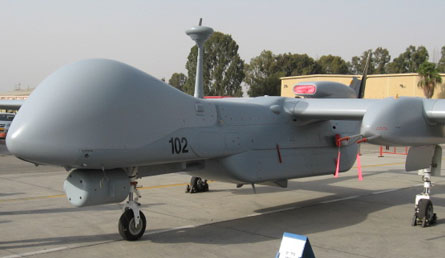The Israeli air force has for the first time displayed its Israel Aerospace Industries Eitan endurance unmanned air vehicle prototype with sensor payloads fitted.
Shown to the media at Tel-Nof air base on 8 October, the Eitan's displayed sensor fit comprises a belly-mounted synthetic aperture radar pod, and what appears to be a modified Elop advanced multi-sensor payload system beneath its nose. It also carries two conformal signals intelligence arrays - most likely interferometers - near the base of its satellite communications fairing.
 |
|---|
© Arie Egozi |
Analysis of the air vehicle configuration suggests that its modular SAR payload's forward-facing radome is intended to support penetrating missions rather than support generic wide-area roles, for which a sideways-looking fixed array would be more appropriate. The pod fairing's flared profile suggests either wider lower lobes on a fixed array, or a limited movement mechanical array, with its VHF antenna indicating the presence of a dedicated datalink.
A large thermal exhaust located beneath the sensor pod confirms the use of an active cooling system, while the size of the UAV's payload bay also indicates a high level of power amplification and an on-board SIGINT processing capability.
The Israeli air force says flight testing of the 4t Eitan air vehicle - also referred to as the Heron TP - will continue through 2008, and that once this has been completed, it intends to put the design into series production.
Two of the air force's IAI Heron 1 UAVs are meanwhile being adapted for use as maritime patrol aircraft. The modified systems will start operational duties later this year, initially alongside the Israeli navy's IAI Westwind 1124 Seascan aircraft, but later replacing them.
The air force-flown UAVs will be equipped with Elta Systems maritime search radars and stabilised long-range optical systems from IAI's Tamam division, with navy personnel to operate their maritime payloads.
Source: Flight International



















